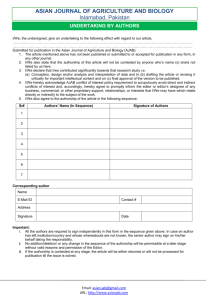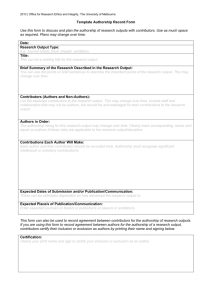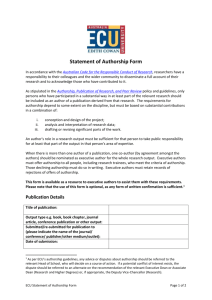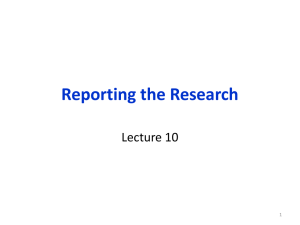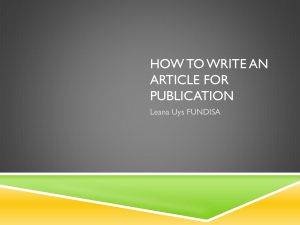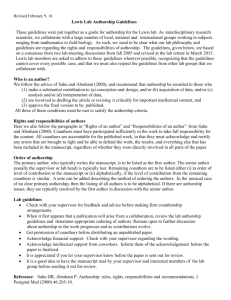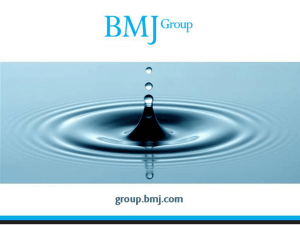Draft Authorship policy - Glasgow Caledonian University
advertisement
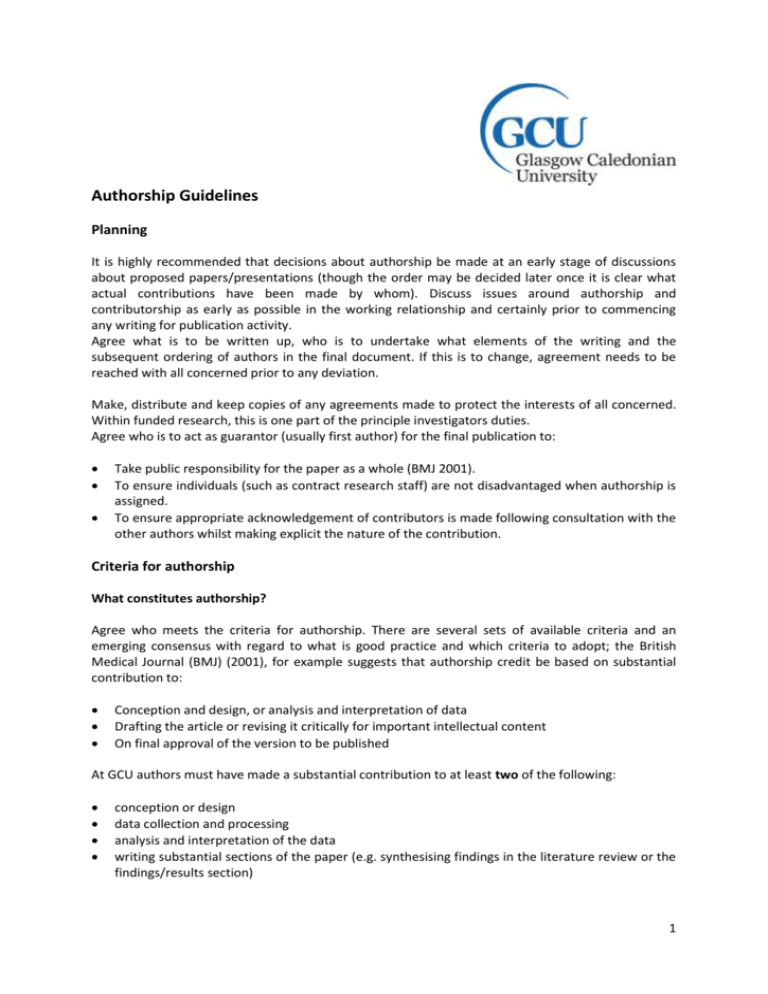
Authorship Guidelines Planning It is highly recommended that decisions about authorship be made at an early stage of discussions about proposed papers/presentations (though the order may be decided later once it is clear what actual contributions have been made by whom). Discuss issues around authorship and contributorship as early as possible in the working relationship and certainly prior to commencing any writing for publication activity. Agree what is to be written up, who is to undertake what elements of the writing and the subsequent ordering of authors in the final document. If this is to change, agreement needs to be reached with all concerned prior to any deviation. Make, distribute and keep copies of any agreements made to protect the interests of all concerned. Within funded research, this is one part of the principle investigators duties. Agree who is to act as guarantor (usually first author) for the final publication to: Take public responsibility for the paper as a whole (BMJ 2001). To ensure individuals (such as contract research staff) are not disadvantaged when authorship is assigned. To ensure appropriate acknowledgement of contributors is made following consultation with the other authors whilst making explicit the nature of the contribution. Criteria for authorship What constitutes authorship? Agree who meets the criteria for authorship. There are several sets of available criteria and an emerging consensus with regard to what is good practice and which criteria to adopt; the British Medical Journal (BMJ) (2001), for example suggests that authorship credit be based on substantial contribution to: Conception and design, or analysis and interpretation of data Drafting the article or revising it critically for important intellectual content On final approval of the version to be published At GCU authors must have made a substantial contribution to at least two of the following: conception or design data collection and processing analysis and interpretation of the data writing substantial sections of the paper (e.g. synthesising findings in the literature review or the findings/results section) 1 Participation in acquisition of funding or the collection of data does not on its own justify authorship. All authors should have critically reviewed successive drafts of the paper and should approve the final version. As a matter of good practice early drafts of papers should include details of authorship and other credits to help resolve any future disputes. All authors should have agreed the final draft prior to submission and approve any refinements made by the editor. Everyone who is listed as author should be able to defend the paper as a whole (although not necessarily all the technical details). Agree the management or apportioning of any payment to be received from the publisher in line with each author’s employing organisation policy on such matters, where applicable. Order of authors Corresponding/lead author status is to be assigned to the person making the largest contribution to the paper, and to have led the writing of it, with subsequent ordering in relation to contribution size. A footnote can be used to indicate equal contribution of authors. The order of authors within the list of those who fulfil the above criteria is governed by three rules: (i) The person who has made the major contribution to the paper/taken the lead in writing is entitled to be the corresponding/lead author, or choose their location within the order of authors (e.g. first author). (ii) Those who have made a major contribution to analysis or writing (ie have done more than commenting in detail on successive drafts) are entitled to follow the first author immediately; where there is a clear difference in the size of these contributions, this should be reflected in the order of these authors. (iii) All others who fulfil the above criteria should complete the list in alphabetical order of their surnames. What constitutes contributor/acknowledgements? Contributor status may be agreed for persons who did not meet the criteria outlined above, but who have made some contribution to the work and associated publication. Examples include: grant coapplicants, research assistants, casual research staff, people employed to collect data only, and collaborators in another institution/country who may have provided critical gatekeeper access to sites Responsibility and advance clearance Principal investigators (or project supervisors) are personally responsible for the content of publications arising from the grant (even if not always necessarily authors). This means principal investigators can be held responsible for fraud, plagiarism, double publication, breaches of confidentiality, misrepresentation or gross error in papers. Draft papers intended for publication, or abstracts being submitted to conferences, therefore must be shown to, and be cleared by, the principle investigator. Arbitration Decisions about authorship, the order of authors, and those to be included in the acknowledgements should normally be made by the first author in consultation with the other authors and the principle investigator. If no consensus can be reached then the grant holders (in the case of a grant-funded 2 project with multiple applicants) or Chair of School Research Committee or Head of relevant Research Institute will adjudicate. Student work In principle, guidelines relating to the publication of student work should follow those outlined above. However, in some disciplines and for some students there are a range of publication options which may exceed the guidelines outlined above. 1. Options for Publications from student dissertations include: A. Publishing the thesis, in its entirety, on dedicated dissertation websites. For example, the University of Glasgow has this facility in some disciplines. GCU does not have this facility at present. These services make the dissertation available to the general public, through the www, and may raise the profile of the author. B. Self-publishing the dissertation through private publishing companies. This route can be very expensive, and depending on the service offered, can mean little more than the student receiving a bound copy (or copies) of the dissertation. Some publishers offer web publication instead of, or in addition to, hardcopy publishing, and others purport to have the dissertation included on academic databases. Overall, self-publishing through private companies is not a route highly recommended by GCU; students are advised to seek the counsel of their supervisor before entering any agreements for this form of publishing. C. Taking specific chapter(s) or theme(s) from the dissertation and using them and/or further research for publication in a non-peer-reviewed journal. This may be suitable for research which is not sufficiently novel or well-developed for publication in a peer-reviewed journal. (See, for example, the Wellcome Trust: http://www.wellcome.ac.uk/Aboutus/Publications/Wellcome-History/index.htm) D. Taking specific chapter(s) or theme(s) from the dissertation and using further research to develop these into a form that is suitable for submission to a peer-reviewed journal. Different journals, even within the same discipline, will have different emphases (eg practise and experience, empirical research, theoretical approaches, cross-disciplinary or crossjurisdictional research, student-led research (eg Aberdeen Student Law review)) and advice on this should be taken into consideration when selecting a journal. E. Utilising the literature review (usually the introductory chapter(s) of the dissertation) as the basis for further research into the same, or a related, question. Authorship must be discussed before the work is written. (See guidelines at the end of this document.) F. There are some journals, often electronic, which are aimed at the doctoral/immediate postdoctoral market. (See, for example: http://www.sussex.ac.uk/history/research/usjch) 2. Supervision for Publications from Student Dissertations At first instance, students are to discuss potential publications with the dissertation supervisor. If the supervisor declines to become involved with further publications, or does not facilitate progress within 6 months of the initial discussion, other academic staff may have the option of discussing potential publication with the student. 3 The following points must be discussed prior to the commencement of any work on publications from student dissertations: A. Agreed destination of the work (ie specific journal, website, archive etc); B. Plan for stages of work required to get the material published; C. Timeframe for completion of the work stages, including corrections; D. Attribution of authorship E. The implications of plagiarism and poor referencing on both the academic and the student. For the sake of professional integrity, it is expected that drafts of jointly-authored work would be circulated to all authors, prior to submission. Note also that many journals require that all authors sign the journal’s copyright form and an attribution of authorship, prior to publication. If it is likely that the student will have left GCU before publication is finalised, this should be acknowledged as soon as possible, and suitable arrangements should be agreed upon, prior to the student leaving GCU. Where work is submitted to a peer-reviewed journal, students will usually require staff assistance in appropriately dealing with reviewers’ comments. 3. Intellectual Property and the GCU Regulations A. Undergraduate and Taught Post Graduate Students Regulation 2.5 affirms that students do not retain copyright over their dissertations. However, good academic practise requires that GCU staff engage with students to ensure that dissertation material is used and attributed appropriately. Reg 2.5 Save where the relevant Assessment Board has determined otherwise, any materials submitted by a candidate for examination, including written replies to examination papers, essays, dissertations or reports, whensoever written or prepared, will not be returned to candidates and the copyright therein is possessed by the University. Entry to an examination will be deemed to constitute an agreement by the candidate with the University to assign such copyright to the University. B. Higher Degree Students Regulation 13.9 of the Higher Degree regulations affirms that copyright of the thesis remains with the student. Reg 13.9 The copies of the thesis/portfolio submitted for examination shall remain the property of the University but the copyright in the thesis/portfolio shall be vested in the candidate. 4 Sources Adapted from Health Care Practice R&D Unit, University of Salford Adapted from School of Health Care, Leeds University Adapted from MRC Unit Social and Public Health Sciences Unit British Medical Journal (2005) Authorship and writing guidelines. (19 May 2005) http://www.bma.org.uk/ap.nsf/Content/LIBAuthorshipGuidelines British Sociological Association (2006) Authorship guidelines for academic papers (17 Feb 2006) www.britsoc.co.uk/Library/authorship_01.doc Harvard University (1999) Authorship guidelines. http://www.hms.harvard.edu/integrity/authorship.html Approved by the University Research Committee 18 March 2011 5
